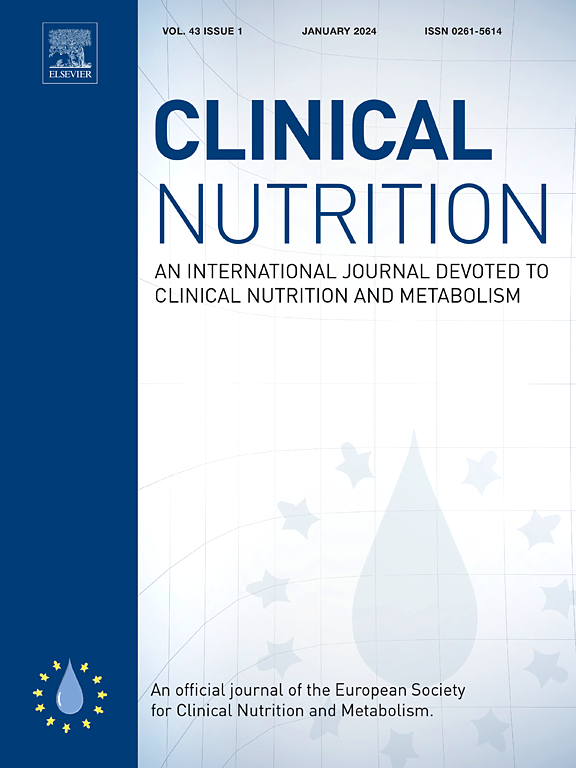Consumption of tree nuts as snacks stimulates changes in plasma fatty acid profiles and adipose tissue gene expression in young adults at risk for metabolic syndrome
IF 6.6
2区 医学
Q1 NUTRITION & DIETETICS
引用次数: 0
Abstract
Background and aims
The prevalence of metabolic syndrome has been increasing in young adults, concomitant with the occurrence of increased abdominal adiposity. We previously reported that consuming tree nuts, as replacement for typical high-carbohydrate snacks, reduces visceral fat and waist circumference in young adults who have one or more metabolic syndrome risk factors. We aimed to investigate the effects of tree nuts snack consumption on plasma and adipose tissue fatty acid profiles along with changes in the expression of adipose tissue genes involved in thermogenesis, glycemia, adipocyte signaling, lipolysis, and immunity.
Methods
A randomized parallel-arm 16-week intervention trial was conducted in 84 adults aged 22–36 years. Participants in both groups were provided with caloric goals for weight maintenance, daily menus, and pre-portioned snacks at every other week visits with study registered dietitians. Changes in dietary fatty acid intakes, plasma and abdominal subcutaneous adipose tissue (SAT) triglycerides fatty acid profiles using gas–liquid chromatography, and the expression of 241 genes in abdominal SAT were evaluated.
Results
Consuming tree nuts snacks increased mono- and polyunsaturated fatty acid intakes yielding a 9-fold greater dietary unsaturated to saturated fat ratio. The tree nuts snack group also had significantly greater improvements in plasma 16:1/16:0 ratio; plasma phospholipids oleic and gamma linolenic acid content; plasma diglycerides, triglycerides, and cholesterol esters oleic acid content; and total plasma monounsaturated fatty acids. While abdominal SAT only showed trends for increased oleic acid content and unsaturated to saturated fat ratio, the tree nuts snacks participants had altered expression of 13 genes in abdominal SAT that have roles in nutrient sensing, energy homeostasis, and vulnerability to obesity.
Conclusions
Replacing typical high-carbohydrate snacks with tree nuts results in more favorable dietary, plasma, and adipose tissue fatty acid profiles that could aid in preventing the development of excess adiposity and cardiometabolic disease states including metabolic syndrome.
Clinical trial registry
This trial was registered at clinicaltrials.gov NCT03969264.
背景和目的:代谢综合征在青壮年中的发病率越来越高,同时腹部脂肪含量也在增加。我们以前曾报道过,食用树坚果作为典型的高碳水化合物零食的替代品,可减少具有一种或多种代谢综合征风险因素的年轻人的内脏脂肪和腰围。我们的目的是研究食用树坚果零食对血浆和脂肪组织脂肪酸谱的影响,以及参与产热、血糖、脂肪细胞信号传导、脂肪分解和免疫的脂肪组织基因表达的变化:对 84 名 22-36 岁的成年人进行了为期 16 周的随机平行臂干预试验。两组参与者均获得了维持体重的热量目标、每日菜单和预先配好的零食,每隔一周接受一次注册营养师的访问。研究评估了膳食脂肪酸摄入量的变化、使用气相液相色谱法检测的血浆和腹部皮下脂肪组织(SAT)甘油三酯脂肪酸谱以及腹部 SAT 中 241 个基因的表达情况:结果:食用树坚果零食增加了单不饱和脂肪酸和多不饱和脂肪酸的摄入量,使膳食中不饱和脂肪与饱和脂肪的比率增加了9倍。树坚果零食组在血浆 16:1/16:0 比率、血浆磷脂油酸和伽马亚麻酸含量、血浆甘油二酯、甘油三酯和胆固醇酯油酸含量以及血浆单不饱和脂肪酸总量方面也有明显改善。虽然腹部 SAT 仅显示出油酸含量和不饱和脂肪与饱和脂肪比率增加的趋势,但树坚果零食参与者腹部 SAT 中 13 个基因的表达发生了改变,这些基因在营养感应、能量平衡和易患肥胖症方面发挥作用:结论:用树坚果代替典型的高碳水化合物零食,可获得更有利的膳食、血浆和脂肪组织脂肪酸谱,有助于预防过多脂肪和包括代谢综合征在内的心血管代谢疾病的发生:该试验已在 clinicaltrials.gov NCT03969264 上注册。
本文章由计算机程序翻译,如有差异,请以英文原文为准。
求助全文
约1分钟内获得全文
求助全文
来源期刊

Clinical nutrition
医学-营养学
CiteScore
14.10
自引率
6.30%
发文量
356
审稿时长
28 days
期刊介绍:
Clinical Nutrition, the official journal of ESPEN, The European Society for Clinical Nutrition and Metabolism, is an international journal providing essential scientific information on nutritional and metabolic care and the relationship between nutrition and disease both in the setting of basic science and clinical practice. Published bi-monthly, each issue combines original articles and reviews providing an invaluable reference for any specialist concerned with these fields.
 求助内容:
求助内容: 应助结果提醒方式:
应助结果提醒方式:


